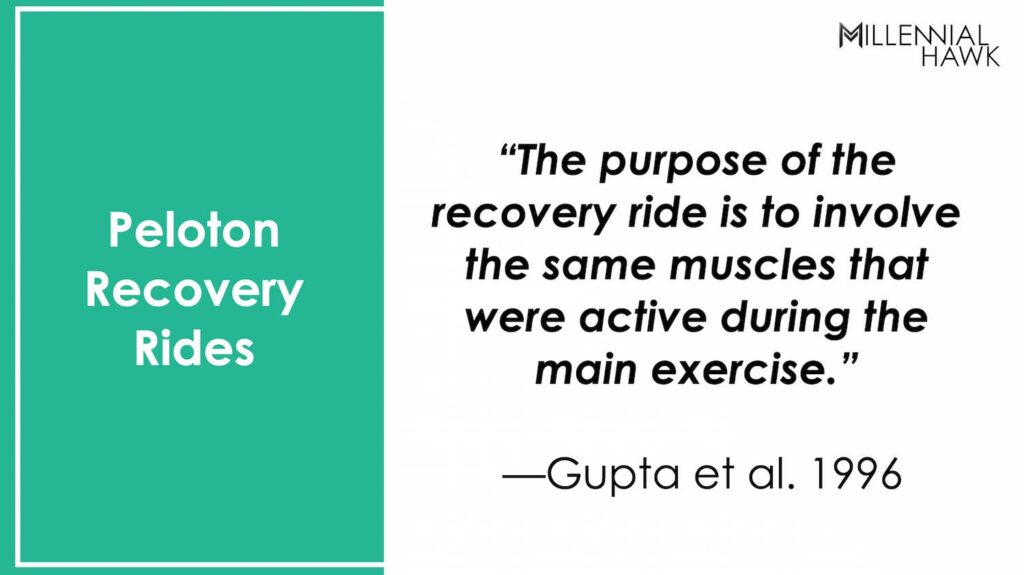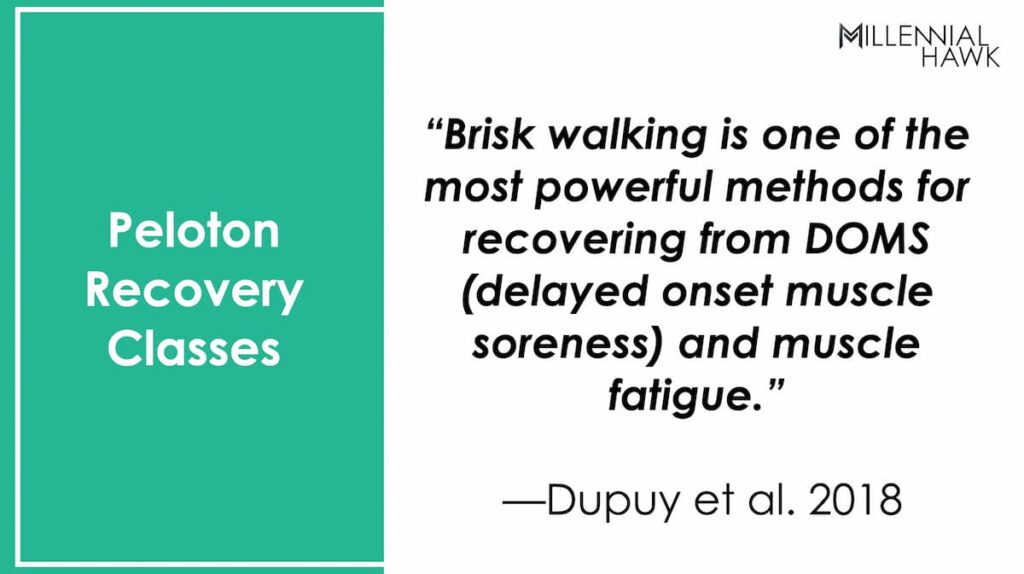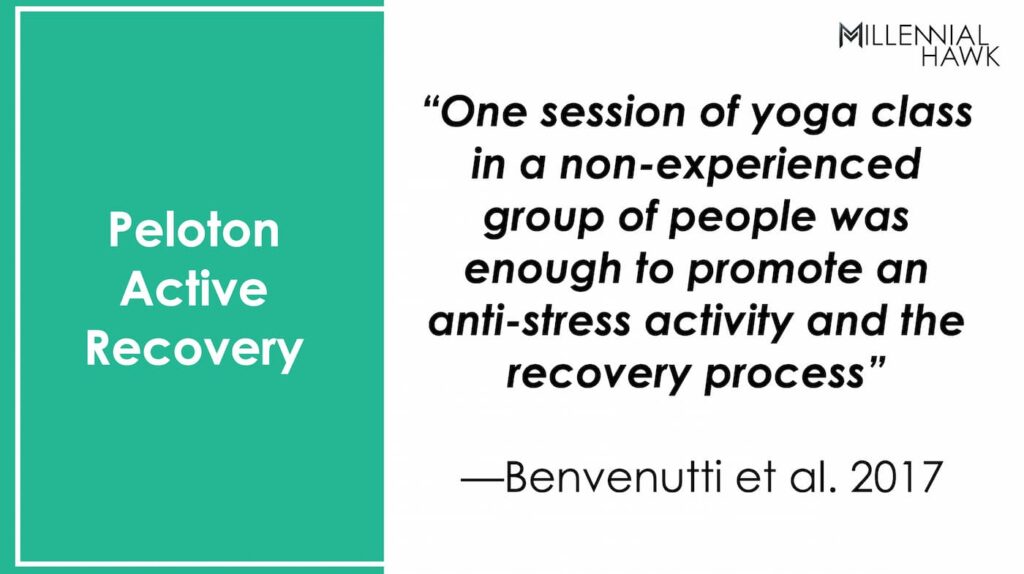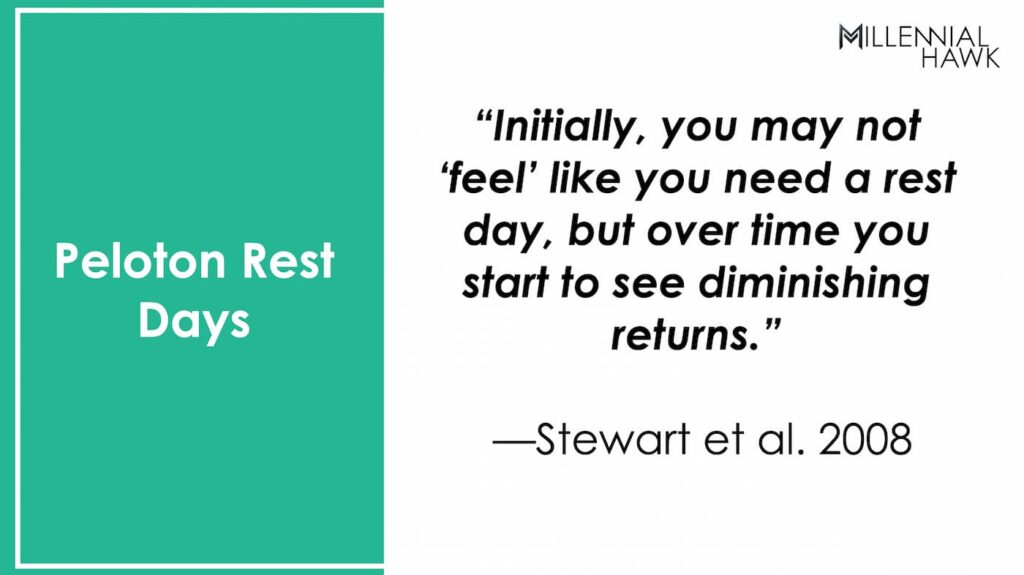
Peloton recovery classes refer to a wide range of activities that promote physical and psychological recovery to help your body bounce back after a tough workout. They aim to make you feel better by facilitating post-exercise recovery on delayed onset muscle soreness (DOMS), reducing muscle tension, perceived fatigue, and inflammatory markers after physical exercise.
Peloton recovery classes encompass cycling rides, walks, runs, and rows, along with various forms of stretching, yoga, and foam rolling. The main difference between Peloton recovery rides and low-impact rides lies in intensity and duration. However, both are suitable for athletes, fitness enthusiasts, and individuals in need of a rest day. These classes are easily accessible and available to all four Peloton memberships, including Peloton Free classes.
Peloton recovery rides aren’t the only methods and treatments you can do on your rest days to facilitate the body’s rapid return to a pre-exercise state. Alongside the best Peloton recovery classes, which are listed below, other recovery alternatives include engaging in light aerobic activities, prioritizing adequate sleep and rest, consuming nutrient-rich post-workout meals, utilizing deep tissue massages, wearing compression garments, and taking ice baths or cold showers.
- Peloton Recovery Rides
- Peloton Recovery Runs
- Peloton Walk and Talk
- Peloton Recovery Rows
- Peloton Recovery Stretch
- Peloton Restorative Yoga
- Peloton Foam Rolling
1. Peloton Recovery Rides
A Peloton recovery ride is a specific type of cycling workout designed to facilitate post-exercise recovery by reducing factors like muscle soreness, fatigue, and inflammation. These rides typically last for 20 to 30 minutes and are conducted by Peloton instructors like Mayla Wedekind, Ally Love, and others.
Peloton recovery rides are not about sweating, leaderboard records, maximizing your power output, or burning calories; they are more about reducing your blood lactate concentration (BLC) and creatine kinase (CK) concentration, helping the body return to a pre-exercise state more quickly.
It’s less about calming and soothing music and more about lower intensity, cadence, and resistance. The best times to do Peloton Recovery rides are either immediately after your main workout or on your rest days, along with other forms of active recovery such as walking, stretching, or meditation. The following table shows a list of all recent Peloton Recovery rides.

| Class | Instructor | Date |
|---|---|---|
| 20 min Recovery Ride | Mayla Wedekind | 12 June 2023 |
| 20 min Prenatal Recovery Ride | Mayla Wedekind | 11 June 2023 |
| 20 min Recovery Ride | Ally Love | 24 November 2023 |
| 20 min Recovery Ride | Charlotte Weidenbach | 16 November 2023 |
| 20 min Recovery Ride | Cliff Dwenger | 30 October 2023 |
| 20 min Recovery Ride | Camila Ramón | 27 October 2023 |
| 20 min Recovery Ride | Charlotte Weidenbach | 16 October 2023 |
| 20 min Recovery Ride | Charlotte Weidenbach | 29 September 2023 |
| 20 min Recovery Ride | Mayla Wedekind | 23 September 2023 |
| 20 min Recovery Ride | Denis Morton | 20 September 2023 |
| 20 min Recovery Ride | Hannah Frankson | 30 August 2023 |
| 20 min Recovery Ride | Bradley Rose | 11 August 2023 |
| 20 min Recovery Ride | Erik Jäger | 6 August 2023 |
| 20 min Prenatal Recovery Ride | Robin Arzón | 1 August 2023 |
| 20 min Recovery Ride | Charlotte Weidenbach | 27 July 2023 |
| 20 min Recovery Ride | Mayla Wedekind | 8 July 2023 |
| 20 min Recovery Ride | Hannah Corbin | 20 June 2023 |
| 20 min Recovery Ride | Mayla Wedekind | 13 May 2023 |
| 20 min Recovery Ride | Mayla Wedekind | 5 May 2023 |
| 20 min Vesak Recovery Ride | Sam Yo | 5 May 2023 |
| 20 min Recovery Ride | Erik Jäger | 23 April 2023 |
| 20 min Recovery Ride | Mayla Wedekind | 18 March 2023 |
| 20 min Recovery Ride | Ben Alldis | 13 March 2023 |
| 20 min Recovery Ride | Matt Wilpers | 21 February 2023 |
| 20 min Recovery Ride | Bradley Rose | 13 February 2023 |
| 20 min Recovery Ride | Jess King | 2 February 2023 |
| 20 min Recovery Ride | Erik Jäger | 25 January 2023 |
| 20 min Recovery Ride | Mayla Wedekind | 24 January 2023 |
| 20 min Recovery Ride | Cliff Dwenger | 13 January 2023 |
| 20 min New Year’s Day Recovery Ride | Sam Yo | 1 January 2023 |
2. Peloton Recovery Runs
Peloton recovery runs are short-distance running workouts, suitable not only for beginners but also for anyone looking to reduce muscle soreness after a long day or week. They are designed to aid in recuperation and enhance overall fitness and work great when combined with stretching, foam rolling, and cold showers. These runs typically include a warm-up period, followed by a series of drills and a cooldown phase.
The primary focus of Peloton recovery runs is to promote muscle recovery and relaxation, helping you stay consistent in your workouts. It’s more about maintaining a steady pace rather than doing tempo runs. Ideally, you should aim for heart rate zones 1-2, which is below 65% of your maximum heart rate, allowing you to maintain a conversation without any problems.
The best Peloton instructors for recovery runs are Becs Gentry and Matt Wilpers, as they both specialize in marathon training and recovering from long-distance events. Here’s a table with the most recent Peloton recovery runs.
| Workout Duration | Instructor | Date |
|---|---|---|
| 20 min Recovery Run | Matt Wilpers | Thu 11/16/23 @ 5:00 PM |
| 20 min Recovery Run | Hannah Frankson | Wed 11/15/23 @ 7:30 PM |
| 30 min Recovery Run | Becs Gentry | Thu 10/12/23 @ 4:00 PM |
| 15 min Recovery Run | Mayla Wedekind | Fri 9/29/23 @ 5:00 PM |
| 30 min Recovery Run | Marcel Maurer | Fri 7/21/23 @ 7:00 AM |
| 20 min Recovery Run | Matt Wilpers | Thu 7/13/23 @ 5:00 PM |
| 20 min Recovery Run | Marcel Maurer | Sun 6/25/23 @ 1:00 PM |
| 20 min Recovery Run | Becs Gentry | Thu 6/22/23 @ 3:35 PM |
| 15 min Recovery Run | Mayla Wedekind | Fri 6/16/23 @ 5:24 PM |
| 20 min Recovery Run | Alex Toussaint | Tue 6/6/23 @ 4:00 PM |
| 20 min Recovery Run | Susie Chan | Wed 4/19/23 @ 8:47 AM |
| 30 min Recovery Run | Susie Chan | Fri 4/14/23 @ 10:00 AM |
| 30 min Recovery Run | Marcel Maurer | Fri 4/7/23 @ 7:00 AM |
| 15 min Recovery Run | Becs Gentry | Mon 1/30/23 @ 4:00 PM |
| 15 min Recovery Run | Jeffrey McEachern | Thu 1/26/23 @ 1:00 PM |
| 15 min Recovery Run | Tobias Heinze | Sun 1/22/23 @ 9:45 AM |
| 30 min New Year’s Day Recovery Run | Tobias Heinze | Sun 1/1/23 @ 2:00 AM |
3. Peloton Recovery Walks
Peloton recovery walks, also known as Peloton walk and talk, are 20-30 minute walking workouts, led by instructor Matty Maggiacomo, designed for reducing muscle pain and active recovery on your rest day from Peloton. While they may not be officially labeled as recovery walks, they are ideal for post-workout recuperation.
The best time to do these low-intensity walks is on your day off or immediately after a long-distance run, and they are best paired with other recovery methods like breathing exercises, soft tissue mobilization, and hydrating with electrolyte-rich water. The best Peloton recovery walks include the following.

- 30 min Peloton Walk & Talk
- 20 min Peloton New Tracks Walk
- 15 min Peloton Walk + Run
- 15 min Peloton Country Pop Walk
- 30 min Peloton 80s Walk
- 30 min Peloton Holiday Walk
- 30 min Peloton Power Walk
- 20 min Peloton 2000s Walk
- 20 min Peloton 2010s Walk
- 20 min Peloton Todo Ritmo Walk
- Extra 10: Peloton Walk
4. Peloton Recovery Rows
Peloton Recovery Row is a 20-minute low-intensity rowing workout designed to aid in post-exercise recovery. These sessions are led by various Peloton instructors, such as Ash Pryor, Katie Wang, Adrian Williams, Alex Karwoski, and Matt Wilpers. They focus on gentle rowing exercises aimed at reducing exercise-induced muscle damage and inflammation, as demonstrated in a 2017 study by Jonathan M Peake from Queensland University of Technology.
Peloton recovery rows are best done immediately after an intense rowing session and can be stacked or bookmarked for future use. The muscle groups primarily targeted during Peloton recovery rowing workouts include the glutes, hamstrings, quads, core, hips, and other muscles. The following list shows the best Peloton row classes for active recovery.
- 20 min Peloton Recovery Row with Ash Pryor from October 13, 2023
- 20 min Peloton Recovery Row with Ash Pryor from August 30, 2023
- 20 min Peloton Recovery Row with Katie Wang from July 21, 2023
- 20 min Peloton Recovery Row with Ash Pryor from July 14, 2023
- 20 min Peloton Recovery Row with Adrian Williams from May 17, 2023
- 20 min Peloton Recovery Row with Ash Pryor from April 7, 2023
- 20 min Peloton Recovery Row with Alex Karwoski from March 10, 2023
- 20 min Peloton Recovery Row with Matt Wilpers from February 9, 2023
- 20 min Peloton Recovery Row with Ash Pryor from November 10, 2022
- 20 min Peloton Recovery Row with Matt Wilpers from November 10, 2022
5. Peloton Recovery Stretch
Peloton Recovery Stretch is a 10-20 minute full-body stretching class, although it’s not officially labeled as active recovery or a post-exercise stretch. You can find these classes, which incorporate both static and dynamic stretching, effective not only for reducing muscle tension but also for providing lower back pain relief, improving range of motion, and preventing muscle injuries.
While recent research, such as José Afonso’s 2021 study, indicates that stretching may not have a significantly greater impact on recovery than passive methods, other research provides a different perspective. For instance, a 2018 study by Nikos C. Apostolopoulos from the University of Toronto found that low-intensity stretching can effectively reduce perceived muscle soreness in the short term (0-24 hours) and up to 72 hours post-exercise, compared to a control group without stretching.
For me, doing the 20-minute Full Body Stretch class with Adrian Williams on Peloton really loosened up my leg muscles. It’s been a game changer – now I can hop in and out of my car, lace up my boots, and pull on my socks without any hassle or getting out of breath. Here are the best Peloton stretch classes for your rest day.
- 20 min New Year’s Day Recovery Stretch with Matty Maggiacomo
- 20 min Evening Stretch with Matty Maggiacomo
- 15 min Full Body Stretch with Hannah Corbin
- 15 min Full Body Stretch with Cliff Dwenger
- 15 min Full Body Stretch with Eric Jäger
- 20 min Full Body Stretch with Andy Speer
6. Peloton Restorative Yoga
Peloton Restorative Yoga, also known as Peloton Recovery Yoga, refers to a chilled-out yoga session perfect for unwinding and easing stress. Restorative yoga classes are ideal for those who feel sore all over and want to relieve muscle tension, as shown in the 2022 study by Gary Deng from Memorial Sloan Kettering Cancer Center.
Peloton Restorative Yoga is all about taking it easy and tuning into relaxation. These classes, lasting between 5 to 45 minutes, are perfect for winding down. Imagine lying on blankets, surrounded by pillows and candles, just chilling out. It’s not about stretching or flexibility; it’s a total break from the day-to-day hustle.
Restorative yoga is fantastic for calming your nervous system, reducing stress, and aiding recovery after intense workouts. It’s a chance to lay back in comfy yoga poses, fully supported, and let go of all the stress. The best Peloton restorative yoga classes for active recovery are shown in this table.
| Class Duration | Instructor | Date |
|---|---|---|
| 20 min Restorative | Kirra Michel | Wed 11/29/23 @ 12:30 AM |
| 10 min Restorative | Nico Sarani | Tue 11/28/23 @ 8:05 PM |
| 30 min Restorative | Kirra Michel | Wed 11/22/23 @ 12:30 AM |
| 10 min Restorative | Kristin Mcgee | Wed 11/8/23 @ 6:35 PM |
| 10 min Restorative | Aditi Shah | Wed 10/25/23 @ 6:35 PM |
| 10 min Restorative | Mariana Fernández | Mon 10/16/23 @ 8:05 PM |
| 15 min Restorative | Chelsea Jackson Roberts | Tue 10/10/23 @ 1:15 AM |
| 20 min Restorative | Aditi Shah | Wed 10/4/23 @ 6:00 PM |
| 10 min Restorative | Kristin Mcgee | Fri 9/29/23 @ 1:15 AM |
| 15 min Restorative | Mariana Fernández | Thu 9/28/23 @ 1:15 AM |
| 15 min Restorative | Nico Sarani | Mon 8/7/23 @ 6:35 PM |
| 20 min Restorative | Mariana Fernández | Thu 8/3/23 @ 1:05 AM |
| 10 min Restorative | Chelsea Jackson Roberts | Tue 8/1/23 @ 1:15 AM |
| 20 min Restorative | Kristin Mcgee | Thu 7/27/23 @ 2:05 PM |
7. Peloton Foam Rolling
Peloton Foam Rolling, also known as self-myofascial release, is a practice where you use a foam roller to massage and release tension in your muscles and fascia. These classes are excellent for recovery because they help desensitize restricted tissues, reduce muscle stiffness, and restore your range of motion, as shown in a 2020 study by Sharief Hendricks published in the Journal of Bodywork and Movement Therapies.
Peloton foam rolling classes are considered the best for body recovery, not only after cycling but also after prolonged periods of less-than-ideal positions, such as sitting for extended periods. These positions can have an impact on our body’s form and movement.
When it comes to Peloton foam rolling instructors, there are several excellent options to choose from. However, for active recovery, one standout instructor for foam rolling classes is Hannah Corbin. Her classes are designed to help reduce tension in various muscle groups, making them ideal for recovery.
What is Peloton Active Recovery?
Peloton active recovery is the practice of incorporating lighter and less physically intense activities to support the body’s recuperation. According to a 2019 systematic review conducted by Robert O. Ortiz Jr. and Amanda J. Sinclair Elder, active recovery interventions lasting 6-10 minutes consistently demonstrated positive effects on athletic performance in professional, collegiate, and competitive adult athletes.
Peloton instructor Leanne Hainsby, on the other hand, defines active recovery as seamlessly incorporated into exercise routines. For example, during Peloton’s HIIT rides, active recovery is included both during the session and in the cool-down phase. It involves maintaining a “base” cadence and resistance to flush lactic acid and hydrogen ions from the muscles, promoting quicker recovery and reducing fatigue.

When asked if riding a Peloton bike is a form of active recovery, the answer is yes, as long as it’s done at a slow pace with low intensity. The goal of active recovery is not to increase intensity or elevate the heart rate but rather to facilitate optimal performance.
You can do Peloton active recovery either during, before, or after workouts, or even on rest days, based on what suits your schedule and training needs. For instance, you could pair Peloton low-impact rides with recovery runs or walks back-to-back.
What is the difference between Peloton Recovery Ride vs Low Impact Rides?
The difference between Peloton recovery rides and Peloton low-impact rides lies in the fact that low-impact classes incorporate elements of interval training, jogging, and climbing, encouraging riders to be out of the saddle while maintaining their heart rate around 60-70%. This makes the session more strenuous and can range from 15 to 45 minutes. On the other hand, in Peloton recovery rides, which last only 20-30 minutes, the entire class remains at a steady and low intensity, with participants remaining seated in the saddle.
What is the difference between Peloton Recovery Ride vs Rest Days?
Peloton Recovery Rides are workouts designed for active recovery, whereas rest days are complete breaks from physical training, focused on allowing the body to fully recover and repair itself.

What is the best way to spend Peloton Rest Day?
The best way to spend your Peloton Rest day is by pampering yourself with a warm bath or sauna session, munching on anti-inflammatory foods like ginger and turmeric that help with muscle soreness, and giving your body a total break from exercise. My typical Peloton recovery kit includes compression socks, a percussion gun, soaking in a warm bath, and booking a steam room.
Should You Take Rest Days From Peloton?
Yes, you should take rest days from Peloton if your goal is to improve performance or body composition. A 2008 study by Riley D Stewart from the University of Waterloo has shown that prolonged exercise for more than three consecutive days can compromise muscle force and weaken the body.
Do Peloton Instructors Take Rest Days?
Yes, Peloton instructors take rest days. Taking time off is essential for energy, longevity, and performance.
How often should I rest from the Peloton?
Ideally, you should have designated rest time every week from the peloton because it helps to facilitate better results. Reducing rest time can inhibit muscle adaptations and lead to suboptimal performance. For best results, you should implement active recovery workouts on your non-training days.
How many days of rest should I take after a long Peloton ride?
You should spend at least 1-2 days (24 to 48 hours) resting after a long Peloton ride, depending on your fitness level. Skilled and experienced athletes can recover faster due to their higher elimination rate of byproducts compared to beginners.
How Long Should a Peloton Recovery Ride Be?
The Peloton recovery ride should be between 20 to 60 minutes, depending on the time you ride. If your recovery ride is done straight after your main workout, it should take around 20 to 30 minutes. But if it’s done on your rest day, you can spend around 60 minutes.
How to find Peloton Recovery Rides?
The following list outlines how to find recovery Peloton rides.
- Open the Peloton App or Device: Start by launching the Peloton app on your mobile device or access Peloton through your Peloton Bike, Tread, or other compatible devices.
- Navigate to the ‘Classes’ Section: Once the app or device interface is open, go to the ‘Classes’ section where you can browse different workout categories.
- Select ‘Cycling’ Category: Within the ‘Classes’ section, choose the ‘Cycling’ category to explore the range of bike classes available.
- Use the Filter Option: Utilize the filter feature to refine your search. You can filter by class type, instructor, length, music, and more.
- Look for ‘Recovery’ Tags: In the filtered results, look for classes tagged as ‘Recovery’. These are specially designed for low-intensity, recovery-focused rides.
Are Peloton Recovery Classes worth it?
Yes, Peloton recovery rides are a smart choice, especially after those tough, high-intensity Peloton classes. They help to down-regulate after high-volume training, reduce muscle soreness, and increase the elimination rate of blood lactate concentration. This helps to feel less achy for the next day.
What is Peloton Recovery Week?
Peloton Recovery Week is a strategic approach to recovery, typically scheduled every 2-3 months, aimed at combating fatigue and preventing performance plateaus. A well-structured Peloton recovery week consists of 4-5 days of low-intensity activities such as walking, stretching, or light recovery rides, accompanied by ample quality sleep and a diet rich in high-protein and high-fiber foods. On Peloton recovery days, you have the option to engage in active recovery workouts like restorative yoga, outdoor walking, or recovery rides, or opt for passive recovery activities such as reading or meditation to support overall recuperation.
